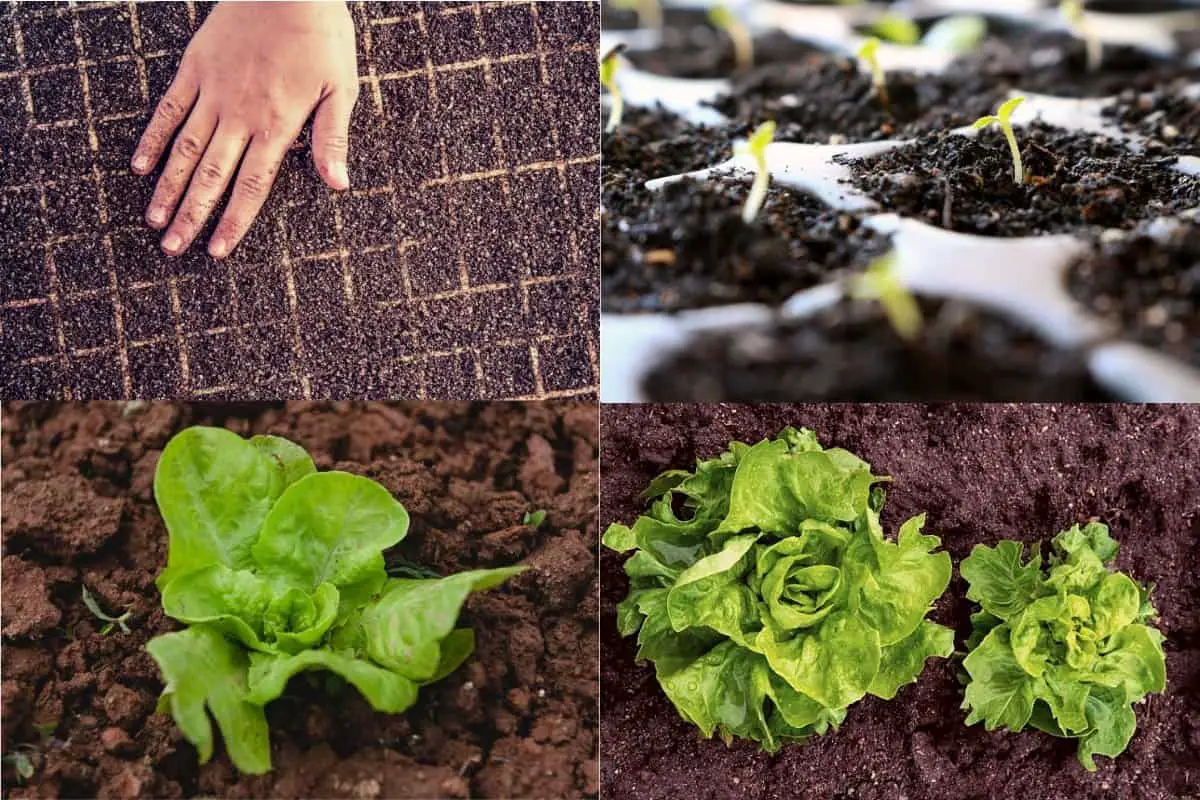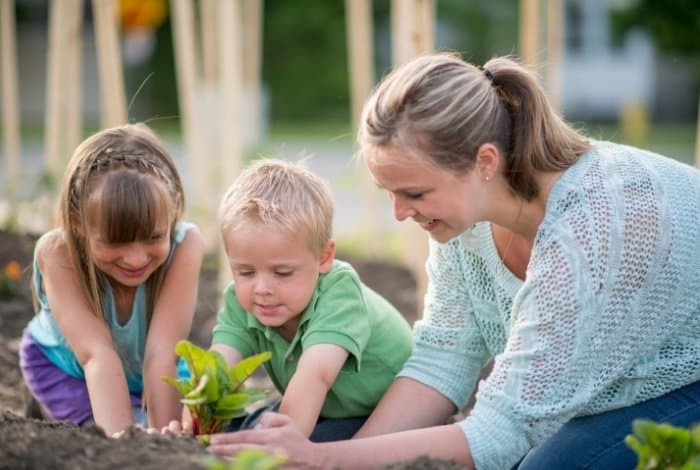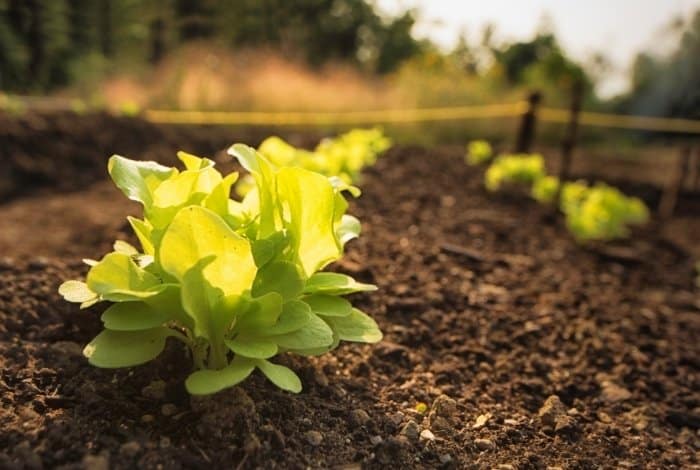Last Updated on February 3, 2023 by Griselda M.
Learning about lettuce growing stages is an essential part of gardening. Growing lettuces from seed is easier and much cheaper than buying the produce from the farmer’s market every time you want to eat your salad.
Lettuce is one of my favorite greens. It is superior in vitamin content and taste. This popular salad green is one of the easiest crops to grow in pots and garden beds.
It grows fast and is ready for picking about a month after planting the seedling. In less than 2 months it forms full heads that are ready for your salad.
Are you ready to learn how to grow lettuce from seeds? It is fairly straightforward to grow these greens. And you can use different methods to achieve this. This guide will show you the best way to do it.
How to Plant Lettuce Step by Step
Knowing how to plant lettuce step by step in your very own garden would afford you abundant harvests that are ready for picking. A garden full of lettuce varieties would not only enhance your landscape, but you will have access to freshly grown vegetables daily. However, some steps should be taken to get the best-tasting romaine or iceberg yields or whichever variety you prefer. Have a look at the informative information below before you start your lettuce garden.
Lettuce planting steps and tips:
1. Choosing a head lettuce variety
If you are patient, then head lettuce varieties are for you as they take a while longer to mature. The most common types include iceberg and romaine lettuce heads which grows best when started in plant pots indoors. It is also advisable to plant heat-resistant varieties if you are deciding to start them in the spring or summer seasons, especially if the climate in your region is hot.
2. Lettuce Seed Preparation
When growing lettuce from seed, starting them in store-bought seed trays or DIY ones is recommended. If you opt for the latter, then you can use newspaper, a box, or an egg tray to prepare your lettuce seeds. Ensure that you fill the trays with a soilless growing medium at least half an inch to the top. To make your soilless growing medium you will need to incorporate equal parts sphagnum moss, perlite, and vermiculite for favorable results.
The soil should also be watered before sowing the lettuce seeds. Keep in mind that the aesthetics of a seed tray is not as vital as the functionality they emit because the lettuce seeds will eventually be planted in the ground after sprouting, while the tray will be discarded or reused.
3. Lettuce seed sowing:
Four to six weeks before the last spring frost is the recommended time to sow your lettuce seeds. It will give them ample time to germinate and sprout during this time. This also makes it convenient to plant them in the ground when the growing season arrives. The lettuce seeds should be evenly scattered into the growing tray compartments and gently sowed into the soilless medium.
4. Sunlight and water requirements:
Ensure that the lettuce seed tray is placed on a sunny windowsill and fed enough water at this stage. Allowing the growing medium to dry out will flaw your plants. A layer of moistened newspaper over the seed tray will serve as protection until they sprout. Thereafter, you should remove the paper. Overwatering is not recommended, so ensure that your lettuce seeds are not waterlogged.
5. Transplanting
Transplant your lettuce seeds into your garden after they sprout. To do this, you should prepare 16-inch rows with holes that are big enough to accommodate the lettuce plant’s root ball. Gently remove the sprouted seedlings from the tray and transfer them into each hole, patting soil over the roots. This will keep the lettuce plants in an upright position as they grow. Thereafter, water the soil thoroughly. Hardening off the seeds before planting will also give you excellent results. You can leave the lettuce seed trays in a covered area outdoors for a couple of days.
6. Fertilization
For the best results, fertilizing your lettuce plants about three weeks after transplanting them is recommended. Fertilizers that are rich in nitrogen include slow-release fertilizers and alfalfa, which are best for enhanced growth and health.
Lettuce Growth Chart
As evidently seen in the lettuce growth chart, these plants go through a variety of stages as they grow. These annual crops are sought after and suitable to grow in most regions. Mediterranean climates and mild coastal regions are great for growing these plants during the cooler months, as stated by the Missouri Botanical Garden. Let’s have a look at the main stages below.
Lettuce Seed Germination Process:
Germination in lettuce seeds is stimulated by the correct growing conditions, which include moisture levels and temperatures. If this is not properly monitored, the seeds may remain in a dormant state. 75 F is the recommended temperature for lettuce seed germination, although some adaptable varieties have the potential to develop in temperatures between 40 F and 80 F.
The germination process takes about 20 days or so. The regulation of soil temperatures can be enhanced with heating pads when seed flats are placed on them and through misting. Seeds leaves are the first set of leaves that grow from the plant.
Lettuce Seedling Development:
Seed leaves and roots are developed after the germination stage in lettuce plants. These developments are referred to as cotyledons. After this occurs, the lettuce plant grows its first set of true leaves, which then develops into a rose-like pattern that enhances as it gets bigger.
The transplanting stage should begin when the lettuce seedlings begin to form rosettes that are about three or four inches in height. The planting holes should be dug a half-inch shallower than the size of the seedling’s root ball. This will ensure that the stalk’s base is slightly elevated above the soil line. Providing a four to six-inch space for your lettuce plants to grow is recommended.
Lettuce Head Development Process:
The lettuce head development process includes the leaves forming a cup shape and developing the head after the rosette stage has passed. While the lettuce head is developing, it is important to keep the soil moist with regular watering. A teaspoon of granular 10-10-10 fertilizer should be added to the base of the soil about four weeks after transplanting. Ensure that you add water thereafter to moisten the fertilizer. At this stage, you should also check the plant for aphid infestations, snails, and slugs and remove them with a spray of water if need be.
Harvesting and Bolting Lettuce Plants:
Ever wondered how long lettuce takes to grow? Well, these sought-after plants mature in 65 to 120 days from germination to harvest, depending on the climate and growing conditions. Lettuce is best harvested before the final growing stage, as it will prevent the plant from developing flower stalks and seeds which happens when not picked.
If you don’t harvest them on time, then you would be left with bitter and tough leaves after a month or so. When your plant is left to mature further and ends up tasteless, this stage is known as bolting, which is due to not enough water, high temperatures, and too much of daylight hours.
Both romaine lettuce growing stages and iceberg lettuce growing stages follow the same development procedures and should be harvested on time. However, picking them in the morning is best to get flavorful lettuce. Remember to cut the lettuce head at the base, which should be in line with the soil. Make use of a shape knife when doing this, as it will give you a cleaner cut. Seeing that these plants are annuals, they won’t regrow after they are harvested, so you will need to restart the planting process from seeds or seedlings all over again.
Quick Facts About Lettuce
- Lettuce is a cool-weather crop that is best grown in fall and spring.
- The seeds germinate in low temperatures of about 4 C or 40 F.
- The ideal growing temperature is between 60 to 65 F or 16 to 18 C
- Lettuce requires 6 to 8 hours of direct sun but can also be grown in partial shade with 2-3 hours of sun
- Loose-leaf varieties grow faster than the other types and can grow in low light
- Lettuce does well in pots too because they have a shallow root system
- They do not thrive in frost – frost kills them
- They prefer soil that is around 6.0 to 6.8
Step By Step Guide On Growing Lettuces From Seed
Sow lettuce seeds indoors for 4 weeks before transplanting. The seeds germinate in 2 to 10 days or 2 weeks if the soil is too cold. Avoid using soil that is too cold. Keep the soil evenly moist until the seeds germinate and are well established.
If you choose to sow seeds directly in the garden, sow them 4 inches apart. Later on, after germination, thin the seedlings according to the type of lettuce you have planted. Head lettuce leaves them 1- to 12 inches apart, leaf lettuce leaves them 6-9 inches apart. Keep your plants well-spaced to allow good air circulation and avoid diseases. For intensive planting, space the plants about 10 inches apart in a staggered pattern.
Once the soil can be worked on, make planting beds that are ¼ to ½ inch deep. Add compost or old manure to planting beds. Compost feeds the soil and aids in moisture retention.
Transplant your lettuce seedlings into the prepared planting beds. Allow them time to grow and in about 2 months you can harvest your lettuce. If you would wish to have an extended harvest, make successive sowing every week.
Avoid planting lettuce where endive, radicchio, artichokes, or escarole have grown recently.
Look out for aphids, cutworms, flea beetle, leaf miners, earwigs, slugs, and snails that attack lettuce. Early spotting of any of these insects helps with early treatment with the right pesticide.
Caring For Lettuce Growing From Seed
Fertilize
Lettuce thrives in soil that is high in organic material with plenty of compost and a good supply of nitrogen. These nutrients make them grow fast. Fertilize your lettuce 3 weeks after transplanting with a slow-release fertilizer or organic alfalfa.
Moisture
Keep the soil moist but not overly wet. Your soil should drain well so that it doesn’t retain water. Lettuce will tell you when it needs water by looking at it. If the leaves show signs of wilting, sprinkle them with water and water them properly. You can use organic mulch to help conserve moisture, suppress weeds, and keep the soil temperatures cool during the warm months.
Weeding
If you notice weeds growing, weed by hand if need be. But be careful of damaging the plant’s roots because they are shallow.
Harvesting Lettuce
- Harvest your lettuce heads when they are full in size just before maturity. The leaves taste fresh when still young and tender.
- Harvest the ready lettuce leaves by removing the outer leaves so that the center leaves continue to grow.
- Romaine, Butterhead, and loose-leaf types can be harvested by removing the outer leaves, digging up the whole plant, or cutting the plant an inch above the soil surface.
- If you leave your lettuce to mature, they get woody and bitter and go bad quickly. Check your garden every day to identify lettuces that are ready to be picked.
- Pick your ready lettuce early morning when the leaves are most fresh and crisp before they are exposed to the sun.
- If you harvested through cutting, you can choose to wait for new leaves to grow or plant a second round of seeds.
- Once harvested, keep your lettuce in your refrigerator for about 10 days in a loose plastic bag.
AeroGarden Salad Greens Mix Seed Pod Kit
Planting Lettuce
We have equipped you with all the knowledge you need for growing lettuces from seed. You can go ahead and confidently grow these salad darlings and enjoy them as often as you wish.
FAQs
How long do lettuces take to grow from seed?
If you buy a packet of seeds, they should be labeled with the estimated time for growth from seed to harvest. The range of this time is usually two weeks to four weeks, but some varieties can take as little as one week and others can take as long as six weeks. You can also check with your local gardening store or other reputable source to see what they recommend.
Why grow lettuce?
My experience has shown me that you can easily grow a beautiful salad in your own garden. Lettuce is easy to grow and has very few requirements.
For lettuce seed, you can grow it indoors in a pot or directly in the ground. The first method is easier and safer (more control). The second one is more natural and requires less space, but is more prone to pests and diseases.
How do you grow lettuce seeds?
This is an easy to follow guide on how to grow lettuce seeds. If you are looking for a good lettuce seed, then this is the guide for you. We’re going to start from the beginning and go through all the steps to growing lettuce seeds. We’ll also be going over the best lettuce varieties for the garden, so that you can get a great yield.
What You Will Need 1-2 Lettuce Seeds A small pot (3-4 inches in diameter) A tray Seeds Lettuce Seed Grower’s Kit If you are going to buy a kit, then you should definitely buy the one from Gardeners Supply. They have everything you need to grow lettuce seeds:
pots, soil, fertilizer and more. You can find them here. You can also check out their YouTube channel for tips on growing lettuce. How To Grow Lettuce Seeds Lettuce seeds are easy to grow, and this is the best way to get started growing your own lettuce.
Most of these seeds will come in packets or containers, and you’ll need to make sure that they’re kept in a very dry place, like a cool, dark cupboard.
What month do you plant lettuce seeds?
Sow your seed in the fall or early spring, depending on what type of seed you're planting. It's best to sow seeds outdoors in a place protected from the sun's rays, such as a greenhouse or cold frame. Planting in a warm room indoors will encourage germination, but it may take much longer.
What is the fastest way to germinate lettuce seeds?
I've always done it in a large plastic container with a layer of paper towels. I put about an inch of water in the bottom and place the container on top of that. Then I cover it with plastic wrap. Then I put the lid on the container and leave it for about 3 days (it will be too cold at first, so I usually put it under my heating vent).
Does lettuce like full sun?
Some people might think that they can grow it in a shade garden, but lettuce is a very sun-sensitive plant, and if you don't get at least six hours of direct sunlight, you won't get any growth. You'll have to make sure to water the plants regularly, especially if you are growing them in the ground because their roots are quite shallow.
Caroline is a gardener who loves to get down to the nitty–gritty of gardening. She proudly proclaims herself as a ‘dirt worshipper‘ and can often be found deep in the garden, covered in soil and singing to her plants. As a self–proclaimed ‘plant whisperer‘, Caroline believes that plants need love and attention just like any other living thing, and she loves to give them both. When she‘s not tending to her garden, you can often find her researching the latest gardening trends, or teaching others how to make their gardens thrive





